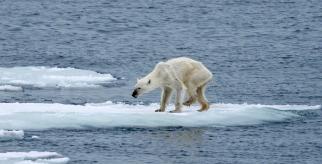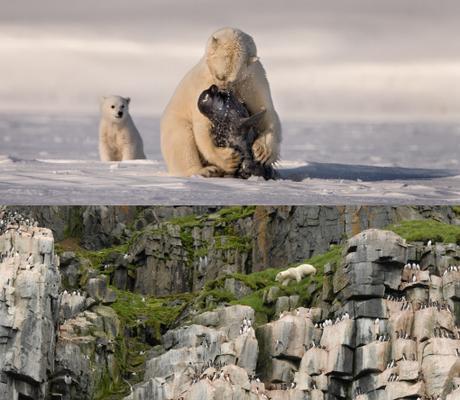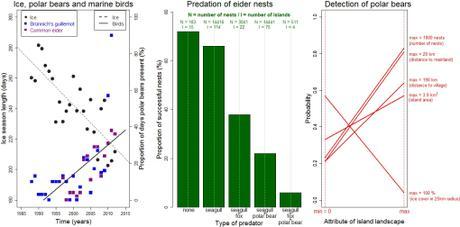
Emaciated female polar bear on drift ice in Hinlopen Strait (Svalbard, Norway), in July 2015 – courtesy of Kerstin Langenberger (www.arctic-dreams.com)
Evolution has designed polar bears to move, hunt and reproduce on a frozen and dynamic habitat that wanes and grows in thickness seasonally. But the modification of the annual cycle of Arctic ice due to global warming is triggering a trophic cascade, which already links polar bears to marine birds.
Popular and epicurean gastronomy claims that the best recipes should use seasonal veggies and fruits. Once upon a time, when there were no greenhouses, international trade routes, or as much frozen and canned food, our grandparents enjoyed what was available at the time. So in some years we had plenty of cherries, while during others we might have feasted on plums.
The polar bear (Ursus maritimus) is an iconic predator relying on seasonal food. The life history of their main prey, i.e., juvenile ringed seals (Pusa hispida), is finely tuned to ice dynamics in response to annual fluctuations of environmental temperatures. Those years in which winter ice coverage is wide, individual polar bears can consume some 50 seals, which provide them with plentiful energy reservoirs to survive the summer months. On the contrary, if winters are ice-poor, seals might not be at close reach and the white ursid might face famine over the summer – and skinny bears are becoming a common (and sad) sight. As a result, recent observations postulate an obligate transition of the diet of this carnivore from marine mammals on ice to birds on land.

Polar bears on Spitsbergen (Svalbard, Norway) hunting a ringed seal from a breathing hole at Billefjorden Fjord and lurking for Brünnich’s guillemots and their nests at Alkefjellet Cliff (courtesy of Roie Galitz and JoAnne Simerson, respectively). More than half of Svalvard Archipelago (~60,000 km2) is ice-blanketed in winter and hosts the Barents Sea polar bear subpopulation. Overall, the IUCN catalogues polar bears as ‘vulnerable’, with a current population of ~ 26,000 individuals in 19 subpopulations comprising mostly Canada, Greenland, the Russian Federation and Alaska-USA. Ice loss owing to climate change is the top threat to the species because of their reliance on an ephemeral habitat dependent on sea-surface and atmospheric temperatures. Across the circumpolar Arctic range, polar bears have increased predation on guillemots (Uria), geese (Anser, Branta, Chen), seagulls (Larus) and ducks (Somateria), posing a potential conservation problem for the bird species themselves (2).
To quantify polar-bear predation on Brünnich’s guillemots (Uria lomvia) and common eiders (Somateria mollissima), Samuel Iverson monitored some 33,000 nests on 230 islands (> 1,000 km of coastline altogether) in the region comprising the Bay and the Strait of Hudson in Canada (3). Since the 1980s, this area has experienced an annual reduction by 2 months of polar-bear habitat (ice layer withstanding up to 700 kg of bear!). Throughout, the onset of the annual thaw has arrived seven days earlier per decade, while the ice build-up has been delayed gradually between autumn and winter. Iverson and his team did transects on foot on each island and found that polar-bear visits at bird colonies has increased 7 fold in the last 40 years. In total, they observed 22 adults and 4 pups on 16 islands, and faeces, hair and fresh footprints on 47 additional islands.

Habitat and prey features of polar bears from the David Strait and Foxe Basin subpopulations (3). The left panel shows the reduction in length of the ice season since the 1980s (2 to 3 days annually), measured as the number of days with frozen sea surface < 30 % of the total open-sea area in the passage from the Bay to the Strait of Hudson (Canada). Throughout, interactions of polar bears with marine birds (on East Bay and Coats islands) have been increasing gradually up to a maximum of 40 and 90 days/100-day interval of the full nesting period for common eiders and Brünnich’s guillemots, respectively. The histogram shows that out of 32,592 eider nests monitored, only 1 % (n = 183 nests) were intact (on i = 15 islands), and nearly 90 % were predated by seagulls (Larus spp.) alone (114 islands) and by seagulls and polar bears together (75 islands); crucially, bear-attacked nests with additional predatory trails of seagulls and/or foxes (Vulpes spp.) had the lowest rates of success, down to 6 to 22 %. The right panel shows probabilities of detecting a polar bear on eider-nesting islands according to five landscape attributes (in parentheses) varying from magnitude zero (min) to their maximum (max); clearly, polar bears are most frequent in iceless islands (because they can be trapped within from summer to the beginning of autumn) and seem to prefer islands that harbor many nests and are relatively large and far from mainland and human settlements.
Polar bears forage for eggs so voraciously that 78 to 94% of bear-visited eider nests failed – well above nest failure rates caused by the two main natural bird predators locally: seagulls and foxes (34 to 59 %). Modelling bear detection probability as a function of bird abundance and landscape features illustrates that polar bears seem to prefer islands that have three attributes: (i) highest number of nests (= food), (ii) longest distance to villages and mainland (= humans) and (iii) widest ice coverage around each island (= accessibility).
The polar bear is the largest extant bear species – about twice the size of a brown bear (Ursus arctos). Such stoutness partly results from a diet rich in fat, which is abundant in the insulating dermis of marine mammals that constitute most of its prey menu. Polar bears are indeed the most carnivorous bear species, eating (by order of preference) ringed (Pusa hispida), bearded (Erignathus barbatus), harp (Pagophilus gorenlandicus) and hooded (Cystophora cristata) seals, walrus (Odobenus rosmarus), beluga (Delphinapterus leucas), dolphins and whale carcasses.
Strikingly, both the circulatory and digestive systems of polar bears are genetically equipped to metabolise fat associated with heart diseases in humans (4). Polar bears and ringed seals have co-evolved as a predator-prey complex. Ringed seals give birth to one pup (4 to 5 kg weight) in a labyrinth of several subnivean burrows and (when sensing the presence of a bear) move their pups around until they learn to swap burrows by themselves.
This pinniped is ecologically tied with the margins of fast (anchored to land, icebergs or the sea floor) and pack (drifting) ice. In spring, the ice layer thins and lets the sunlight through, thereby fueling phytoplankton growth and, in turn, a rich community of benthic invertebrates attached to the underwater surface of the ice – seals prey on those invertebrates. During the summer, seals moult, eat little and spend long periods of time on the ice surface. To access the surface, they work holes through the ice using their sharpened and tough flippers that are unique among phocids (see videos here and here). The frontier between ice and the open sea, along with the frequency of seal-made breathing holes and burrows, determine a polar bear’s hunting territories (5) – see predatory scenes here, here and here.
Many bears like to be on ice year round (pagophily), but many females venture into land only for birth – producing twins most often. However, if forced to depend trophically on a terrestrial habitat, polar bears might have a hard time to live on an omnivorous and protein-rich diet of berries, sedges and seaweeds, caribou and small mammals, marine birds and fish (6, 7). Such items could perhaps represent a food supplement, but consumption rates are mostly unknown (i.e., only recorded from a few individuals), while polar bears are likely to be outcompeted for those resources by brown bears: a species evolutionarily tailored to live on land (7).
Recent work shows summer declines in polar bear activity and body temperatures that are typical of fasting animals (8). Certainly, if polar bears fail to modify their physiology (an unlikely event given current rates of global warming) and future diet, increases in fasting periods from 4 to 6 summer months could result in (i) mortality rates of up to 48 % and (ii) reduction in reproductive encounters by 25 % (9).
Ongoing overheating of the Arctic will continue to enhance the fragmentation of the frozen landscape, while rising temperatures will likely get close to the species’ upper thermal limit in many parts of its ancestral native range. All in all by 2050, populations could be restricted to the northernmost stretches of Greenland and of the Canadian Arctic, the low viability of which could lead sooner or later to the extinction of yet another of our living giants (10).
—
by Salvador Herrando-Pérez & David R. Vieites
(with support of the British Ecological Society and the Spanish Ministry of Economy, Industry and Competitiveness)
—
References
- Freitas, C. et al. (2008). Predicting habitat use by ringed seals (Phoca hispida) in a warming Arctic. Ecological Modelling 217: 19-32
- Prop, J. et al. (2015). Climate change and the increasing impact of polar bears on bird populations. Frontiers in Ecology and the Environment 3: 1-12
- Iverson, S. A. et al. (2014). Longer ice-free seasons increase the risk of nest depredation by polar bears for colonial breeding birds in the Canadian Arctic. Proceedings of the Royal Society B 281: 20133128
- Liu, S. et al. (2014). Population genomics reveal recent speciation and rapid evolutionary adaptation in polar bears. Cell 157: 785-794
- Pilfold, N. W. et al. (2014). Polar bear predatory behavior reveals seascape distribution of ringed seal lairs. Population Ecology 56: 129-138
- (Gormezano, L. J. & R. F. Rockwell (2013). What to eat now? Shifts in polar bear diet during the ice-free season in western Hudson Bay. Ecology and Evolution 3: 3509-3523
- Rode, K. D. et al. (2015). Can polar bears use terrestrial foods to offset lost ice-based hunting opportunities? Frontiers in Ecology and the Environment 13: 138-145
- Whiteman, J. P. et al. (2015). Summer declines in activity and body temperature offer polar bears limited energy savings. Science 349: 295-298
- Molnár, P. K. et al. (2010). Predicting survival, reproduction and abundance of polar bears under climate change. Biological Conservation 143: 1612-1622
- Stirling, I. & A. E. Derocher (2012). Effects of climate warming on polar bears: a review of the evidence. Global Change Biology 18: 2694-2706

